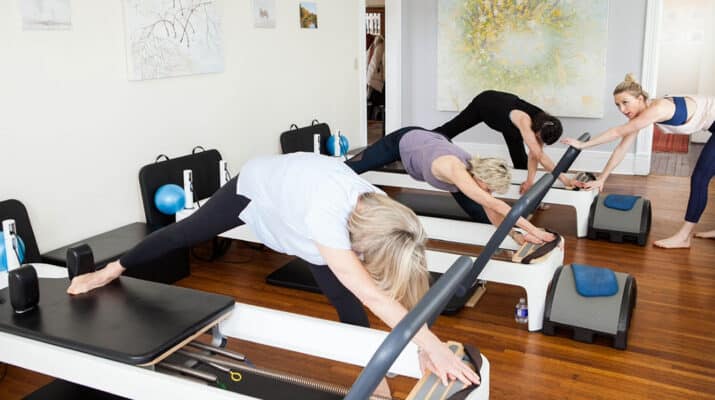Growing in popularity, the practice can help keep you limber and strong
By Deborah Jeanne Sergeant

Popular through studios, videos and online, Pilates provides a system of strength training that helps participants gain muscle and recover from injuries or surgery.
In fact, Joseph Pilates developed the practice in the early 1900s to help bedridden patients develop better strength through breathing exercises and by using springs affixed to their hospital beds.
That rudimentary apparatus became the Pilates Reformer, equipment that current practitioners use.
Numerous styles of Pilates have developed since its founder introduced it.
 “Pilates has a lot of physical and mental health benefits: strength, flexibility, control and overall gracefulness of movement,” said Sarah Griffin-Divincenzo, certified Pilates instructor and owner of Pilates Art Studio in Buffalo. “It’s adaptable to any body, so I can have a range of clientele from an 85-year-old to a 20-year-old athlete. A lot of people like that there is a graceful flow to the workout. It’s kind of in between yoga and strength training. It can be whatever the client needs it to be, especially if they’re doing private lessons. In a class setting, I give a general, whole-body workout that covers all the bases.”
“Pilates has a lot of physical and mental health benefits: strength, flexibility, control and overall gracefulness of movement,” said Sarah Griffin-Divincenzo, certified Pilates instructor and owner of Pilates Art Studio in Buffalo. “It’s adaptable to any body, so I can have a range of clientele from an 85-year-old to a 20-year-old athlete. A lot of people like that there is a graceful flow to the workout. It’s kind of in between yoga and strength training. It can be whatever the client needs it to be, especially if they’re doing private lessons. In a class setting, I give a general, whole-body workout that covers all the bases.”
Working with a certified instructor one-on-one can also help modify Pilates movements to accommodate injuries. But it takes time to see progress. Unlike many types of workouts, its long-term effects are subtle.
 “We move through repetitions,” Griffin-Divincenzo said. “It has a strength training type of workout. If you take a class on the reformer or the apparatuses, there’s spring resistance. Every exercise is also a core exercise because you hold yourself in a certain position. It’s different from yoga where you’re holding a pose. But there are pose type of positions that we do. We really move the body through every direction it moves. That’s what makes a complete workout.”
“We move through repetitions,” Griffin-Divincenzo said. “It has a strength training type of workout. If you take a class on the reformer or the apparatuses, there’s spring resistance. Every exercise is also a core exercise because you hold yourself in a certain position. It’s different from yoga where you’re holding a pose. But there are pose type of positions that we do. We really move the body through every direction it moves. That’s what makes a complete workout.”
Pilates includes working the small, connective tissues are often overlooked with other activities. Much of the equipment used in Pilates is proprietary, such as the Reformer. There’s also the Cadillac (also known as the trapeze table), named jokingly because of the simultaneous introduction of the upscale automobile.
The raised mat — complete with a framework, springs and other apparatuses — allows instructors to not have to get down on the floor with each student to adjust and correct them. The apparatuses aid students who need to improve their physical condition and resistance to challenge them. Students perform movements on an exercise mat also.
“You can do a lot of these functional movements on a mat or on the floor,” said Robyn Stein owner, certified massage therapist and Pilates instructor at REAL Therapeutic Massage + Pilates and Acupuncture in Amherst.
She said that much of the benefit of Pilates has to do with aligning the muscular and skeletal systems, as doing so supports the health of all the body’s systems.
“They work more efficiently when you have more agility and strength with a realigned body,” Stein added. “You create muscle memories with your movements.”
Because Joseph Pilates’ studio was located near a dance school, many dancers came to him to help them recover from injuries. This early association has caused many people to erroneously think that Pilates is a “woman’s activity” or that only ballerinas would benefit from it.
Nancy Shea, certified Pilates instructor and certified yoga teacher and co-owner of Balance Pilates in Williamsville, likes the mind-body connection fostered by Pilates.
“Mind-body movement is my jam,” Shea said. “I also do tae kwon do. They’re both like moving meditation. I say to my clients, ‘Let your body lead the dance.’ We do certain things to help you understand your body better, but I want your body to tell you what you’re doing on a daily basis. We start to correct it so they can be their own advocate. I never want clients to feel like they’re being told what to do.”
By strengthening the core, Pilates helps people improve in many types of athletic pursuits. This may include athletes who want to improve to people recovering from surgery, sedentary lifestyle or an injury.
During their session, “people don’t think they’re doing a lot,” Shea said. “They’ll text me and say they’re feeling so many muscles the next morning. I’m not doing it in an aggressive way.”
She recommends taking a Pilates class once or twice weekly and weight training once or twice weekly.
In addition to improving athletic performance, Pilates improves mobility for supporting day-to-day activities, especially for those coming from physical therapy, according to Shea.
“It takes the isolated movement in physical therapy into functional movement to mimic what they’ll do in life,” she said. “That’s the biggest thing we’ll do.”

